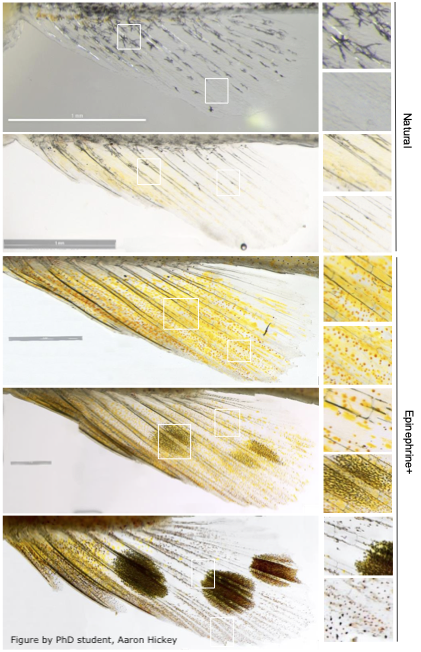
Cellular basis of pigment pattern development in cichlid fishes
Supervisor: Dr Emília Santos
Project summary
We are interested in the genetic, cellular and developmental basis underlying morphological evolution using cichlid fishes as a model system. We study variation in sexually dimorphic pigmentation patterns that are important for male-male competition and female choice – eggspots. These are circular pigmentation markings present on the anal fins of approximately 1500 species of cichlid fishes. Eggspots are a highly variable trait, varying in colour, number and arrangement, both within and between species. They function as badges of status, being sexually selected via female choice in some species and via male-male competition in others. Cichlids are one of the most species rich vertebrate families showing extreme diversity in their colour patterns. They are a fascinating system because despite the morphological diversity, they are genetically very similar, which allows for in depth comparative developmental studies between closely related species. Furthermore, the recent increase in genomic resources, the viability of hybrid crosses and to the application of the genome modification method - CRISPR/Cas9 makes them a highly attractive study system. We use a combination of quantitative and population genomics, developmental genetics to address our questions.
What the student will do
The objective of this project is to determine how tissue environment cues and cellular interactions between different pigment cell classes influence egg-spot pattern formation and variation within species. The student will image anal fin pigmentation pattern development, more specifically eggspots, in wildtype Astatotilapia calliptera and three mutant lines, each lacking specific types of pigment cells (e.g. melanophores, xanthophores and iridophores). The student will use also use single cell RNA sequencing throughout different stages of pigment pattern formation to further identify genes and cells contributing to pattern formation. Finally, we will characterise sequence evolution of the genes showing interesting temporal and cellular patterns of expression across the cichlid phylogeny. For this purpose, we will take advantage of whole genome sequences of over 250 Malawi cichlid species.
References
Eggspots: Santos ME, et al. Nature Communications 2014
Astatotilapia calliptera from Massoko lake: Malinsky M, et al. Science 2015
Lake Malawi cichlids: Malinsky M, et al. Nature Ecology and Evolution 2018

